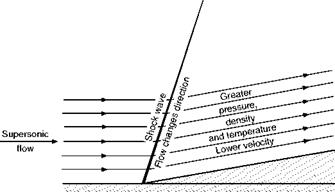Compressive flow
Tet us consider first what happens when supersonic flow meets what we have called a concave corner, or putting it more practically, a sharp, small-angled wedge. One way of describing this kind of corner is to say that if the flow were to go straight on it would intersect the body (Fig. 12.3).
Figure 12.4 (overleaf) shows what happens. The flow will in fact go straight on until it hits something – but what it hits will not be the wedge itself, but the shock wave which is formed by the slowing up of the flow as a result of the point of the wedge being inserted in the flow, and the consequent converging of the Mach Tines (perhaps that wasn’t such a bad explanation after all).
In this type of flow there will be an inclined or oblique shock wave. Now it has already been explained that a shock wave at right angles to the flow causes a sudden reduction in the speed of flow, but a shock wave oblique to the flow causes both a reduction in the magnitude of the velocity, and a change in its direction. The change of direction is a result of the fact that it is only the component of the velocity at right angles to the shock wave which is reduced; the
|
|
|
|
Fig 12.4 Compressive flow other component (along the shock wave) remains unchanged in passing through the shock wave. This is illustrated in Fig. 12.5, and it is clear that the new direction of flow will be parallel to the new surface.
So the flow has turned the corner; the change of direction was sudden and occurred entirely at the shock wave. The flow after the corner is at a reduced velocity (though it may still be supersonic), the lines of flow are closer together, the pressure is higher, the density is higher (the air is compressed, possibly quite appreciably), and the temperature is higher. The Mach Tines, at the lower speed, will be more steeply inclined to the new surface.
Supersonic flow most commonly compresses through a shock wave; and at the leading edge of a wing, or the nose of a body, or at the mouth of a contracting duct, there is – as at this wedge – no gradual change of pressure as with subsonic flow, but a sudden rise in pressure, density, and temperature, and a sudden fall in velocity. This type of flow is called compressive flow. By very careful design it is possible to obtain a gradual compression by avoiding the conditions where the Mach Tines coalesce (Fig. 12.2(c)). The shock compression is, though, much more usual.













